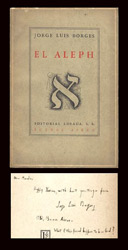|
TBCL The Book
Collector's Library - Borges - Spring - 2011
B O R G E S
A
selection of Signed & Inscribed Presentation Copies from the Master
"I
have always imagined paradise will be a kind of library..." -
Borges
|
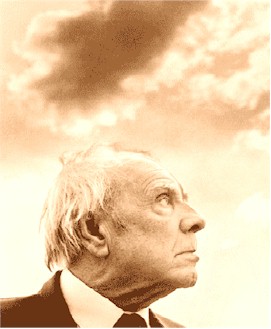
|
IMPORTANT
PRESENTATIONS
1
- INQUISICIONES, 1925 -
Inscribed
to: Ramón Gomez de la Serna
2 -
INQUISICIONES,
1925 - Inscribed
to: Nora Lang
3 -
FICCIONES,
I944 -
Inscribed to: Vicente Barbieri
4 - EL
ALEPH, 1949 -
Inscribed
to: Vicente Barbieri
5 - EL
ALEPH, 1949 -
Inscribed
to: Mandie Molina Vedia
6 - La Muerte y la brújula. 1951
[Death
And The Compass].
The
Dedication Copy
Inscribed to:
Mandie
Molina Vedia
7 -
LEOPOLDO LUGONES, 1955 Inscribed
to Vicente Barbieri
|
1
- INQUISICIONES, 1925 -
Inscribed to: Ramón
Gomez de la Serna
|
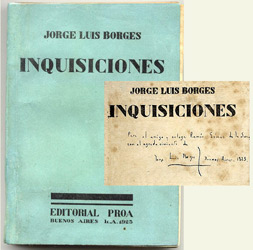
Borges
(Jorge Luis). INQUISICIONES. First edition, Inscribed
presentation copy from the author, A
very good or better example in the original light blue wrappers - name erasure
on the ffe.. [Helft p.28; Becco 50], 8vo, Buenos Aires, Proa, imprenta El
Inca, 1925.$25500
The
presentation inscription reads: "
Para
el amigo y colega Ramón Gomez de la Serna / con el agradecimiento de / Jorge
Luis Borges.
Buenos Aires
1925" [For the friend & colleague Ramon Gomez of the
Serna, with the gratefulness of Jorge Luis Borges Buenos Aires -
1925.
|
Inscribed to the great Spanish author Ramón Gomez de la
Serna.
This
is Borges' first collection of essays. The publication was limited to
500 copies & it was never reissued. Inquisiciones already contains the
seminal concerns that Borges would follow for the rest of his writing
life. It was never reprinted, however Borges followed it with Otras Inquisiciones,
his most important collection of essays. In
Inquisiciones,
Borges is firmly rooted in two traditions, both classic & modern.
The first is Hispanic, from Quevedo "perfecto en las metáforas,
en las antítesis, en la adjetivación, es decir, en aquellas
disciplinas de la literatura cuya felicidad o malandanza es
discernible por la inteligencia" (perfect in metaphores, in
antithesis, in adjectivation, that is to say, in those disciplines of
literature whose felicitous or erroneous usage is discernable by the
intellect), & Torre Villaruel to Unamuno, Herrera Reissig, &
Ramón Gómez de la Serna & Cansinos Asséns, his mentor. The
second tradition is Anglo-Saxon, from Thomas Browne " … un
ensayo bastante malo, … tal vez el primero que se escribió sobre él
en idioma español". ( … a rather bad essay … perhaps the
first that was written about him in Spanish) [Autobiografía, p.80])
to Joyce, including the idealist philosophy of
Berkeley
. The Germanic tradition is also present with a translation of 3
poems: "Soy culpable de la españilización de los versos".
(I am guilty of the Spanish translation of these verses). It is in
"Examen de metáforas" where Borges manifests the
formulation of his own rhetoric which governed his writing through his
Ultraist years to his later works. However years later he retracts
this essay: "basta un solo buen verso no metafórico para probar
que la metáfora no es un elemento esencial … Otro (ensayo)
casificaba las metáforas
como
si se pudiera prescindir sin problema de otros elementos poéticos,
por ejemplo el ritmo y la música". (A single good verse without
a metaphor is sufficient to prove that the metaphor is not an
essential element … Another (essay) classified metaphors as if one
could do away with other poetic elements without any problem, rhythm
and music, for example). [Autobiografía, p.80]. An extraordinary
Copy.
|
2
- INQUISICIONES, 1925 -
Inscribed to: Nora Lang
Inscribed
by Borges to the important Argentine writer, Nora Lange. This
is Borges' first collection of essays. The publication was limited
to 500 copies & it was never reissued. Inquisiciones already contains the
seminal concerns that Borges would follow for the rest of his
writing life. It was never reprinted, however Borges followed it
with Otras inquisiciones,
his most important collection of essays.In Inquisiciones
Borges is firmly rooted in two traditions, both classic &
modern. The first is Hispanic, from Quevedo "perfecto en las
metáforas, en las antítesis, en la adjetivación, es decir, en
aquellas disciplinas de la literatura cuya felicidad o malandanza es
discernible por la inteligencia" (perfect in metaphores, in
antithesis, in adjectivation, that is to say, in those disciplines
of literature whose felicitous or erroneous usage is discernable by
the intellect), & Torre Villaruel to Unamuno, Herrera Reissig,
& Ramón Gómez de la Serna & Cansinos Asséns, his mentor.
The second tradition is Anglo-Saxon, from Thomas Browne " …
un ensayo bastante malo, … tal vez el primero que se escribió
sobre él en idioma español". ( … a rather bad essay …
perhaps the first that was written about him in Spanish) [Autobiografía,
p.80]) to Joyce, including the idealist philosophy of
Berkeley
. The Germanic tradition is also present with a translation of 3
poems: "Soy culpable de la españilización de los
versos". (I am guilty of the Spanish translation of these
verses).It is in "Examen de metáforas" where Borges
manifests the formulation of his own rhetoric which governed his
writing through his Ultraist years to his later works. However years
later he retracts this essay: "basta un solo buen verso no
metafórico para probar que la metáfora no es un elemento esencial
… Otro (ensayo) casificaba las metáforas
como
si se pudiera prescindir sin problema de otros elementos poéticos,
por ejemplo el ritmo y la música". (A single good verse
without a metaphor is sufficient to prove that the metaphor is not
an essential element … Another (essay) classified metaphors as if
one could do away with other poetic elements without any problem,
rhythm and music, for example). [Autobiografía, p.80]. A wonderful
copy.
|
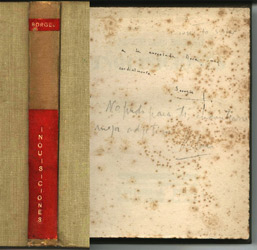
Borges
(Jorge Luis). INQUISICIONES. First edition,
Inscribed presentation copy from the author, A
very good copy with some general foxing - modern cloth, gilt
lettered red spine labels [originally issued only in paperback]. [Helft
p.28; Becco 50], 8vo, Buenos Aires, Proa, imprenta El Inca, 1925
US $18500
The presentation
inscription to Lange (Oliverio Girondo's wife) in his
fastidious early hand reads: "a la
aureolada Nora, muy / cordialmente - / Georgie". A note in pencil below the inscriptions apparently
written by Nora Lange's sister; reads in translation: "He
could not have found a better adjective for you." Borges used
his affectionate diminutive "Georgie", only with his Mother & other close family & friends.
|
3
-
FICCIONES, 1944
Inscribed
to: Vicente Barbieri
|
Inscribed
by Borges to his close friend, one of the most important
Argentine poets, Vicente Barbieri.
Borges
(Jorge Luis). Ficciones
(1935-1944). First edition. Buenos Aires: Editorial Sur, 1944. 8vo., 203pp., frontispiece portrait by Marie Elisabeth
Wrede. A very good
copy in the original blue wrappers - small surface chip at the spine
crown, contents embrowned due to paper acidity as always. [Helft
p.65; Becco 30]. $18850
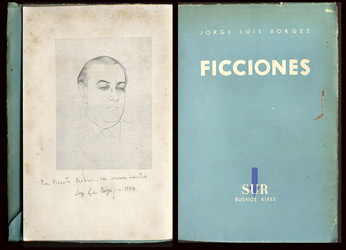
|
The
presentation inscription reads: "
Para
el colega Vicente Barbieri con sincera amistad. / Jorge Luis
Borges - 1944",
[For the colleague Vicente Barbieri with sincere friendship]
3000
copies of this edition were printed. El jardin de los cenderos que se bifurcan
is the predecessor of this, one of the most important works of
fiction of the 20th century. It is sufficient to quote Borges' own
statement: "Ficciones
y El
Aleph
(1949 y 1952) son, según creo, mis libros más importantes". (Ficciones
and El
aleph
are, I believe, my most important books). (Autobiografía
p.111-112). The universe created by Borges' work is an alternative
postulate of reality which, in many ways, influenced Foucault,
Derrida, Paul de Man, Gerard Genette, Umberto Eco, John Updike,
Goddard, Bertolucci, to mention a few from the European camp. We
must also include the
Barranquilla
group and other Latin American writers, i.e., Lezama Lima, Roa
Bastos, Onetti, Cortázar, Sábato, and others. Contains 8 stories
from the previously published El
jardin +
a group of 6 new stories entitled, including "Funes, the
Memorious" &
"Death and the Compass”. Which was dedicated to Amanda Molina Vedia.
Marvelous Literary Association Copy.
|
4 - EL ALEPH, 1949
Inscribed
to: Vicente Barbieri
|
The
presentation inscription reads: "Para
el colega Vicente Barbieri con la amistad de / Jorge Luis
Borges" - [For the colleague Vicente Barbieri with the
friendship of / Jorge Luis Borges]. Front cover vignette by
Attilio Rossi. In Borges' own words: "Ficciones
y El
Aleph (1949 y 1952) son, según creo, mis libros más
importantes". (Autobiografía pp.111-112). The Borgean quest
for the Verb, the Word, which is all words, for the absolute Book,
which is all books, takes flesh in El
Aleph: the One that contains All, exemplified in the
last tale of this collection. On page 139 Borges begins to enumerate
his vision through the Aleph he has found in the cellar of Carlos
Argentino Danieri. "En ese instante gigantesco, he visto
millones de actos deleitables o atroces; ninguno me asombró
como
el hecho de que todos ocuparan el mismo punto, sin superposición y
sin transparencia". (In this gigantic instant, I saw millions
of acts, delightful or cruel; none astonished me more than the fact
that they all occupied the same place, without superposition or
transparency … "Borges enumerates 37 points in all, each
beginning with "vi … " (I saw … ): "Vi el
populoso mar … Vi el alba y la tarde … Vi las muchedumbres de América
… Vi un laberinto roto (era Londres) … Marvelous Literary
Association Copy.
|
Inscribed
by Borges to his close friend, one of the important
Argentine poet, Vicente Barbieri.
Borges (Jorge Luis). El
Aleph. First
edition.
Buenos Aires: Editorial Losada, 1949. A very good or better copy
in the original printed wrappers – Inscribed presentation copy
from the author. The spine with a bit of preservation treatment
common to books from South America. Original
printed wrappers otherwise in very good or better condition. [Helft
p.72; Becco 37], 8vo,
Buenos Aires
: Editorial Losada, Colección Prosistas de España y América,
1949.
$18800
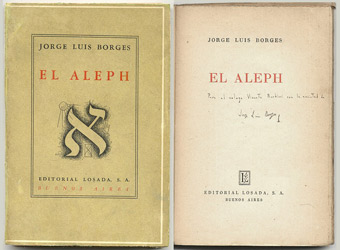
|
5 - EL ALEPH, 1949
Inscribed
to: Mandie Molina Vedia
|
Inscribed
by Borges to his 'love', Amanda Molina Vedia, to
whom he dedicated his landmark 'La Muerte y la
brújula'
[Death And The Compass] in 1951.
|
|
Borges
(Jorge Luis). El Aleph. Buenos Aires:,
Editorial Losada, 1949. First edition. Inscribed presentation copy
from the author. A near fine or better example. Seldom seen in this
condition in the original printed wrappers.
[Helft p.72; Becco 37], 8vo, Buenos Aires: Editorial Losada, Colección
Prosistas de España y América, 1949. $31000.
The
presentation inscription in English reads: "Dear Mandie / Happy
Xmas with best greetings from / Jorge Luis Borges / 1951,
Buenos Aires
- / What if this friend happened to be God?". Front
cover vignette by Attilio Rossi. In Borges' own words: "Ficciones y El
Aleph (1949 y 1952) son, según creo, mis libros más
importantes". (Autobiografía pp.111-112). The Borgean quest
for the Verb, the Word, which is all words, for the absolute Book,
which is all books, takes flesh in El
Aleph: the One that contains All, exemplified in the
last tale of this collection. On page 139 Borges begins to enumerate
his vision through the Aleph he has found in the cellar of Carlos
Argentino Danieri. "En ese instante gigantesco, he visto
millones de actos deleitables o atroces; ninguno me asombró
como
el hecho de que todos ocuparan el mismo punto, sin superposición y
sin transparencia". (In this gigantic instant, I saw millions
of acts, delightful or cruel; none astonished me more than the fact
that they all occupied the same place, without superposition or
transparency … "Borges enumerates 37 points in all, each
beginning with "vi … " (I saw … ): "Vi el
populoso mar … Vi el alba y la tarde … Vi las muchedumbres de América
… Vi un laberinto roto (era Londres) … A spectacular copy
of a Rare Borges title, especially inscribed.
|
6
-
La Muerte y la brújula. [Death And The Compass].
The
Dedication Copy
Inscribed to:
Mandie Molina Vedia
|
Dedication
Copy Of This Landmark Title Story.
Borges
(Jorge Luis). La Muerte y la brújula. [Death And The Compass]. First edition, signed presentation
copy from the author,
original pictorial wrappers,
showing very light use. [Helft p.74; Becco 46], 8vo, Buenos Aires,
Emecé Editores, Colección Novelistas Argentinos Contemporáneos,
1951. $36000
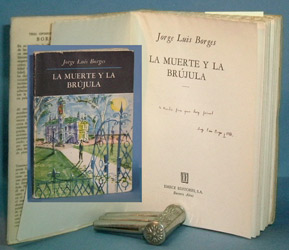
|
The
inscription penned in English, reads:
"To Mandie from
your lazy friend / Jorge Luis Borges - 1951".
Nine tales reappear in this collection, all revised &
corrected for this edition. Hombre
de la esquina rosada, Borges points out, was written
influenced by American movies & Robert Louis Stevenson. Emma
Zunz "está redactada con palabras opacas, in
a style of scrupulous meanness,
como
dijo Joyce de sus Dubliners.
(it is written with opaque words, … , as Joyce had said about his Dubliners).Funes el memorioso "es el que menos me desagrada."
(is the one that least despleases me). Its source is De Quincey's Palimpsest.
Borges wrote it when he felt cornered by the universe: "me sentí
acosado del universo".La
espera is an urban tale, from a true police report read
to Borges by his friend Alfredo Doblas.La
forma de la espada & Tema
del traidor y del héroe pretend to show a romantic view
of Ireland. El jardín de los
senderos que se bifurcan is a type of crime fiction.
Borges hopes that the meaning of it will not come to the reader
until the very last paragraph. La
muerte y la brújula takes place in
Buenos Aires
, in spite of the Nordic or
German street
names. The volume is
dedicated to: Mandie Molina Vedia, who, notwithstanding her life
long friendship was one of Borges' great, life long loves.
|
7 - LEOPOLDO LUGONES, 1955
Inscribed
to Vicente Barbieri
|
Inscribed
by Borges to his close friend, the Argentine poets, Vicente Barbieri.
Borges
(Jorge Luis) in collaboration with Betina Edelberg. LEOPOLDO
LUGONES. First edition. A fine fresh copy in the original
printed wrappers. [Helft p.77; Becco 105], 8vo,, Buenos Aires,
Editorial Troquel, Colección Diálogos del Presente, Number 5, 1955.
$5350
Inscribed
By Borges as follows: "
Para
Vicente Barbieri, afectos y un abrazo. Jorge Luis Borges" [For
Vicente Barbieri, affections & a hug. Jorge Luis Borges]
Leopoldo
Lugones (1874-1938) was a journalist and short-story writer. His
poetical work reflects the Spanish American modernist movement headed by
Ruben Darío, i.e., Lunario
sentimental,
(1909) & Romancero
(1924). To Borges, Lugones represented his Argentinian side - finding
the paths of his own literature by opposing Lugones' Baroque style with
a more Classical stance, in which reality is always a provisional
postulate. Borges returned
to Lugones again & again. A Great Literary Association Copy.
|
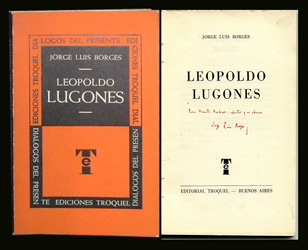
|
|






